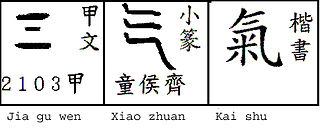
In traditional Chinese culture and the East Asian cultural sphere, qi, also ch'i in Wade–Giles romanization or chi, is believed to be a vital force forming part of any living entity. Literally meaning "vapor", "air", or "breath", the word qi is a polysemous word often translated as "vital energy", "vital force", "material energy", or simply as "energy". Qi is the central underlying principle in traditional Chinese medicine and in Chinese martial arts. The practice of cultivating and balancing qi is called qigong.

Mantak Chia is a Taoist Master. Mantak Chia is the creator of the Healing Tao, Tao Yoga, Universal Healing Tao System, and Tao Garden Health Spa & Resort, located in the northern countryside of Chiang Mai, Thailand. He wrote more than 60 books on Taoist practices and taught the principles of Taoist internal arts. His books have been translated into more than 40 languages. He views himself primarily as a teacher.
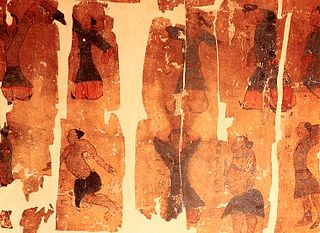
Daoyin is a series of cognitive body and mind unity exercises practiced as a form of Daoist neigong, meditation and mindfulness to cultivate jing (essence) and direct and refine qi, the internal energy of the body according to traditional Chinese medicine. These exercises are often divided into yin positions and yang positions. The practice of daoyin was a precursor of qigong, and was practised in Chinese Taoist monasteries for health and spiritual cultivation. Daoyin is also said to be a primary formative ingredient in the well-known "soft styles" of the Chinese martial arts, of tai chi, and middle road styles like Wuxingheqidao.
In alternative medicine, bodywork is any therapeutic or personal development technique that involves working with the human body in a form involving manipulative therapy, breath work, or energy medicine. Bodywork techniques also aim to assess or improve posture, promote awareness of the "bodymind connection" which is an approach that sees the human body and mind as a single integrated unit, or to manipulate the electromagnetic field alleged to surround the human body and affect health.

Dantian is a concept in traditional Chinese medicine loosely translated as "elixir field", "sea of qi", or simply "energy center". Dantian are the "qi focus flow centers", important focal points for meditative and exercise techniques such as qigong, martial arts such as tai chi, and in traditional Chinese medicine.
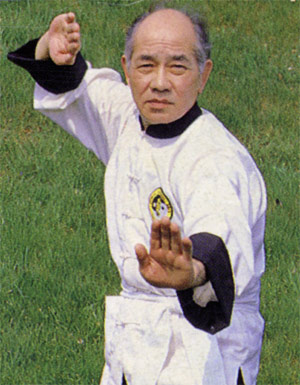
The Lee style of tai chi (李氏太極拳) is closely related to a range of disciplines of Taoist Arts taught within the Lee style including Qigong, Daoyin, Ch'ang Ming, Traditional Chinese Medicine, Taoist alchemy, Feng Shou kung fu, and weapons practice. According to practitioners, it was first brought to the West in the 1930s by Chan Kam Lee and was subsequently popularized by Chee Soo who was the President of the International Taoist Society from 1958 until his death in 1994. The Lee style of tai chi comprises two forms known as 'the dance' and 'the form'. Other exercises include Yifu Shou or 'sticky hands', Whirling Hands, Whirling Arms, and various qi and Li development exercises. Lee style t'ai chi is related to Martial Arts training, and there are five distinct areas of development that comprise the whole Art:
- Physical
- Mental
- Breathing
- Sheng Qi
- Ching Sheng Li.
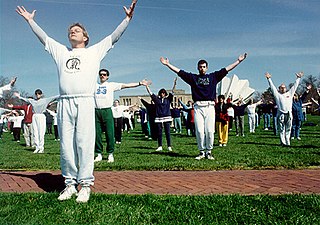
World Tai Chi and Qigong Day (WTCQD), also spelled World T'ai Chi and Ch'i Kung Day, is an annual event held the last Saturday of April each year to promote the related disciplines of tai chi and Qigong in nearly eighty countries since 1999.
Body & Brain, formerly called Dahn Yoga, is a business founded in 1985 by Ilchi Lee that teaches a Korean physical exercise system called Brain Education. In Korean, dahn means "primal, vital energy", and hak means "study of a particular theory or philosophy". News sources have described its exercises as "a blend of yoga, tai chi, and martial arts exercises". Body & Brain is taught through for-profit studios as well as community centers. Ilchi Lee's Brain Education is considered pseudoscience.
Wong Kiew-kit is a grandmaster in the tradition of the mythical Southern Shaolin Monastery in China, which should not be confused with the more commonly known Shaolin Monastery in Henan Province. Wong founded the Shaolin Wahnam Institute in 1982 in order to teach Shaolin arts to the public. Master Wong practiced and learned within a number of famous lineages which place him as a fourth generation successor of the Ven. Jiang Nan and a sixth generation successor of the Ven. Chee Seen both of the Southern Shaolin Temple.

The microcosmic orbit (小周天), also known as the Self Winding Wheel of the Law, is a Taoist qigong energy cultivation technique. It involves deep breathing exercises in conjunction with meditation and concentration techniques which develop the flow of qi along certain pathways of energy in the human body which may be familiar to those who are studying traditional Chinese medicine, qigong, tai chi, Neidan and Chinese alchemy. The exercise can be performed usually at first in a sitting position, but it can also be practiced standing as in Zhan zhuang or with movements included as with tai chi.

Bruce Kumar Frantzis is a Taoist educator who studied Taoism in China.
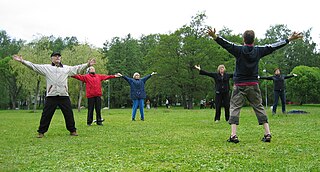
Asahi is a Finnish health exercise based on the eastern traditions of tai chi, qigong, yiquan and yoga, with a western scientific viewpoint. Asahi is designed to suit everybody, regardless of physical condition or age and education level.
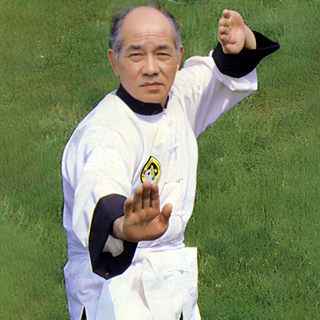
Chee Soo was an author of books about the philosophy of Taoism and in particular Lee-style tai chi, qigong, Ch'ang Ming, Traditional Chinese Medicine and Feng Shou 'Hand of the Wind' kung fu.
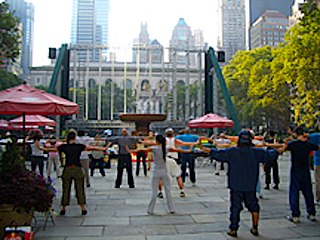
Qigong, is a system of coordinated body-posture and movement, breathing, and meditation used for the purposes of health, spirituality, and martial arts training. With roots in Chinese medicine, philosophy, and martial arts, qigong is traditionally viewed by the Chinese and throughout Asia as a practice to cultivate and balance qi, translated as "life energy".
Maipayat is associated with the emergence of knowledge concerning meditative and prescriptive exercises. Originally recorded late in the Vedic period, in conjunction with Vedanta, is done working from a full-deep yogic breathing, by initiating set movement patterns that nurture creativity and feeds the body with breath energy. This energy is taught in Maipayat to be of the divine energy. The teachings of Maipayat are within many different branches of Tantra and Martial Arts. Similar exercises are taught in tai chi although Maipayat exercises more fluid movements while attempting to align the chakras.
Primordial qigong is a form of qigong purportedly developed by the Taoist sage Chang San Feng.
Practitioners of Lee-style tai chi believe Chan Kam Lee was a Taoist teacher who brought Taoist Arts to the West. According to Chee Soo, Chan Kam Lee established a Taoist Arts school in Red Lion Square in Holborn in 1930 teaching Lee-style tai chi, Qigong, Traditional Chinese Medicine and Feng Shou 'Hand of the Wind' kung fu, and used his knowledge of Chinese Medicine and Herbalism to adapt the Ch'ang Ming diet for Westerners. Chan Kam Lee is referenced in several books written by Chee Soo and published by HarperCollins, but there is no corroboration of his existence independent of Chee Soo's accounts.
Qigong, the Chinese practice of aligning breath, movement, and awareness for exercise, healing, and martial arts training, has a history that extends back more than 4,000 years. Contemporary qigong is a complex accretion of the ancient Chinese meditative practice xingqior "circulating qi" and the gymnastic breathing exercise daoyin or "guiding and pulling", with roots in the I Ching and occult arts; philosophical traditions of Confucianism, Taoism, and Buddhism, traditional Chinese medicine and martial arts; along with influences of contemporary concepts of health, science, meditation, and exercise.
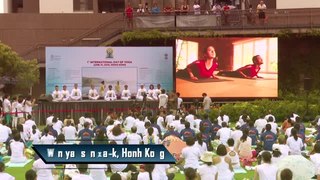
The International Day of Yoga has been celebrated across the world annually on June 21 since 2015, following its inception in the United Nations General Assembly in 2014. Yoga is a physical, mental and spiritual practice which originated in ancient India. The Indian Prime Minister Narendra Modi, in his UN address in 2014, had suggested the date of June 21, as it is the longest day of the year in the Northern Hemisphere and shares a special significance in many parts of the world.











